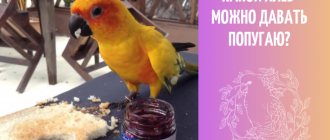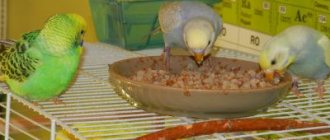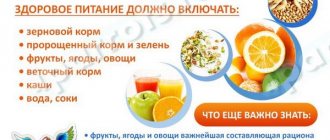Lovebirds make great pets as they are small, active and cheerful birds. Proper feeding will ensure that they feel good. Start by choosing food that is suitable and healthy for these parakeets. You can then create a feeding schedule. It will ensure that your parrots get enough food and nutrients on a regular basis. From our article you will learn what you can feed lovebirds at home. In addition, sometimes in order for the chicks to develop well, they are fed by hand. Although this can be a very time consuming process. We will also tell you further about how to properly feed lovebird chicks.
The nuances of feeding lovebirds
According to ornithologists, it is necessary to combine grain feed with vegetables and fruits.
Details of feeding parrots
But not all fruits are healthy. Products for the poultry menu must be chosen very carefully. Everything they eat in the wild is different from the food they are given in captivity.
Daily norm
In order for the diet to be balanced and correct, you need to not only know what to feed lovebirds, but also have an idea of the norms for the different components. Different foods must be given in certain proportions so that all the necessary vitamins enter the body of feathered pets.
Proper feeding should be done according to the recommendations below:
- approximately 35 grams of dry grain feed are given per day;
- wet food is given in the amount of 5 grams per day;
- on protein days, wet food is reduced to 2 grams;
- The main food needs to be poured in the evening, and additional food is given during the day.
Setting a Feeding Schedule
Metabolic processes in birds occur quite intensively. Food is digested and absorbed within 120-180 minutes.
Therefore, parrots constantly need to replenish their supply of nutrients. Even a short period of fasting harms them.
Collectors offer food to breeding birds every 3 hours. In my opinion, this is not necessary. The optimal number of feedings at home is 2, in the morning and before 18:00.
Lovebird feeding schedule
What not to feed
The bird must have its own food - this is the rule. The parrot should not be allowed to peck food prepared for people. Fried, fatty, seasoned foods are strictly prohibited for lovebirds. In addition to ready-made food from the common table, birds should not be given spicy vegetables, some fruits and food that is not typical for parrots in nature.
A short list of prohibited products:
- onion, garlic, hot pepper;
- potatoes, eggplant;
- cheese, butter;
- mushrooms;
- seafood;
- bird cherry, sweet cherry, cherry;
- persimmon, avocado.
Important: Salt is contraindicated for lovebirds, but porridge with water is allowed. If you run out of bird food, you can boil fresh pearl barley or buckwheat. Do not season with anything, cool and place one tablespoon of porridge in the feeder.
A varied diet includes all the necessary elements for the health of lovebirds. The use of high-quality mixtures and fractional feeding are the main conditions for the prevention of obesity in poultry. Flavoring and mineral supplements complement the regular diet and contribute to the good mood of the parrots.
How to create a complete diet for your pet
The daily menu of lovebirds should include:
Complete diet for a parrot
- sprouted wheat – a source of vitamins B and E (give every day, alternate with barley on a 7/7 day schedule);
- hawthorn berries (I feed thawed fruits, my parrots love them very much);
- fresh corn (if the cob is hard, then it must first be boiled without salt and spices. For 1 pet, one slice 2-2.5 cm wide is enough);
- apples (local ones can be given with the peel; imported ones must be peeled).
It is advisable to change menu components. I add pear, tangerine and orange slices to my diet. In June-August I offer berries: gooseberries, cherries.
During the nesting season, I feed my pets an egg. I boil it hard and grate it on a fine grater, then mix it with carrots. I alternate this dish with low-fat cottage cheese.
In spring, I recommend adding greens and fresh tree branches to the menu.
The more varied the diet, the more vitamins and other nutrients the bird receives. It is advisable to immediately accustom lovebirds to soft food. You cannot give them one grain.
Variety in your parrot's diet
Store-bought feed
Pet stores sell various brands of grain food, and the owner can find the right mixture for his lovebird. When choosing, you need to look at the date of manufacture, integrity of the packaging, and shelf life. A cardboard box is not the best packaging option, as it does not guarantee the safety of the food. Vacuum bags with a zipper are convenient, they protect food from moisture and do not spoil for a long time. The preferred method of sealing is a double sealing method: the product is filled into a tight bag, which is placed in a box.
To feed lovebirds, you need to buy mixtures intended for medium-sized parrots. All their components are specially selected taking into account anatomical features. Lovebirds find it inconvenient to pick up small seeds with their beaks, which budgerigars easily absorb. Mixes for feeding large birds contain whole corn, sunflowers, and peas. Medium-sized parrots often leave such food untouched - they cannot crush dry grains and swallow them whole.
Ready-made food does not always contain the necessary ingredients. Parrots do not like some supplements, such as brightly colored vitamin pellets. If you notice that your pets refuse commercial food or are reluctant to eat it, experiment with the composition. A dry “cocktail” prepared with your own hands can be a tasty and healthy treat for lovebirds.
Fresh vegetables and herbs
I feed my parrots seasonal vegetables:
List of healthy vegetables and herbs for a parrot
- zucchini;
- broccoli;
- cauliflower;
- carrots;
- pumpkin;
- cucumber;
- tomatoes;
- sweet bell pepper (can be with seeds);
- beets;
- radish;
- turnip.
You should not give white cabbage, because it contains substances that provoke irritation of the gastrointestinal tract.
My birds really love celery greens and scalded nettles. I also sometimes offer them some arugula. You can feed parrots with strawberry, clover, and fireweed leaves.
What's prohibited
Some products contain elements that are dangerous to birds. When they enter a parrot's body, they become toxic, which ultimately leads to serious poisoning, and in severe cases can cause the death of the pet. When purchasing food and other additives, you should carefully study the composition on the packaging. If it is not indicated, then it is better to check with the seller or refuse the purchase altogether.
Dangerous products:
- potatoes in any form;
- pepper;
- meat fish;
- cheese;
- oil;
- garlic;
- sorrel;
- sour cream;
- mushrooms;
Branches of oak, lilac, pear, bird cherry and poplar are harmful to parrots. Before serving cherries, plums, peaches and other similar products, the pits should be removed. Food from the human table is also dangerous.
Enriching your diet with fruits and berries
My lovebirds happily eat apples and citrus fruits: tangerines and oranges.
Lovebird eats a tangerine
The fruits recommended by experienced breeders are presented in the table:
| Fruits | Berries |
| Pineapple, bananas, pear (without core), feijoa, kiwi, peach, plum, | Quince, watermelon (seasonal), lingonberry, melon, rose hip, blackberry, strawberry, sea buckthorn, cranberry, blueberry, raspberry, rowan, currant. |
Mango, papaya, and persimmon are not allowed.
How lovebird chicks hatch and after what time
The female will have to hatch the chicks from three weeks to a month. Over this period, cracks will begin to appear on the eggshell. This provides the chicks with oxygen inside and improves their breathing. Consequently, cracks in the shell are a sure sign that the brood will hatch within a period of 12 hours to a whole day.
After hatching, the chicks will spend at least another month in the nest, and only after that they will leave it. The parent birds will feed them for the first two weeks after leaving the nest box, and then they will be able to feed on their own.
What to avoid when feeding poultry
It is prohibited to include in the diet:
- preservatives;
- sugar;
- fats.
Parrots should not eat food from the table - this must be carefully monitored. It is forbidden to feed the bird from the mouth. Human saliva contains dangerous microorganisms that can harm your pet.
Preservatives
Candied fruits and store-bought juices should not be given. Dried apricots, figs, and industrially produced prunes may also contain harmful impurities.
porridge for parrots (basic)
Sugar
The bird gets a sufficient amount of this element from berries and fruits. Exceeding the norm can lead to the development of diabetes.
Occasionally it is allowed to treat your pets with unrefined brown sugar. I give no more than 3-4 crystals per month.
Fats
I do not recommend giving walnuts or cashews. Fermented milk products are allowed, but in strictly limited quantities. Optimal fat content is up to 3%.
I sometimes treat my birds with baby fruit puree without cream, mixed with cottage cheese.
If your pet leads a passive lifestyle, such food should be abandoned.
Choose a high-quality seed mixture that your birds will enjoy eating.
Your task is to find or make your own mixture that has a wide variety of grains. What seeds do lovebirds eat from seeds? Perfect for: millet, canary grass seeds, oatmeal, niger seeds, flax, sunflower, safflower and rapeseed.
Other seed mixtures may contain soybeans, fennel seeds, rye, whole brown rice, sesame and poppy seeds.
- The seeds do not have much nutritional value for lovebirds. Therefore, they are recommended to be given only in very small quantities as treatment. They should never be your bird's only food source.
- Use only fresh seed mixture. If it smells dusty or old, you shouldn't give it to lovebirds.
Feeding the chicks
Very young chicks are fed by their parents. If there are no problems, they don’t pluck or peck at them, then there’s no need to interfere. I recommend giving food to babies using a syringe. The basis of the diet is children's dairy-free porridge.
Parrots up to 3 months eat:
- soft food (carrots with eggs, cottage cheese);
- baby fruit food.
You can add 3 drops of Vita-Sol to your food. You need to be careful with vitamins. Better their lack than their excess.
Feeding Fischer's lovebird chicks
Additional feeding
Lovebirds are herbivorous birds, but they benefit from eating animal food from time to time. In nature, parrots catch insects - the body requires proteins. The owners give their charges boiled chicken eggs, cottage cheese, kefir:
- Adults can be offered a hard-boiled and chopped egg once a week, young ones - twice;
- liquid fermented milk products are served on a spoon;
- cottage cheese 2% fat – 1 tbsp. l. at one time, with a break of at least three days.
Attention! Parrots should not be overfed - when keeping lovebirds at home, there is a high risk of obesity. A bird can eat often, but little by little.
It is especially important what lovebirds are fed when the nesting season begins. If a couple is preparing to become parents, these birds are fed daily until the female sits on her eggs. After hatching the chicks, the female’s body is weakened and exhausted; she needs a vitamin supplement to restore her strength. The veterinary drug Beaphar, Trivit or a little fish oil is dripped into the food.
Clean your pet's beak after feeding
Cleaning helps avoid the accumulation of bacteria and the development of dangerous diseases.
Food for lovebirds part 1
The instructions look like this:
- Soak a soft towel in warm boiled water.
- Carefully handle the chick's beak.
- Wipe your pet’s “face” dry.
The procedure is carried out after each feeding.
Adults clean off food debris on their own. You can make their task easier by purchasing and placing a strong mineral stone in the cage.
Drink
A necessary condition for keeping parrots is that there should always be fresh water in the drinking bowl. Lovebirds can be given bottled or filtered water at room temperature. Plain tap water is quite suitable for parrots, but it must first be soaked until the chlorine evaporates. Boiled water should not be offered to a parrot, since when heated, its structure changes and some of the beneficial properties disappear.
For illnesses, lovebirds are advised to drink herbal tea - a drink that relieves inflammation and calms the nervous system. For infusions you can use dry chamomile and rose hips.
Important: Any liquid must be poured into a clean drinking bowl. When cleaning is done poorly, pathogenic microorganisms appear in containers.
Hatching eggs is a very important period.
Having laid 4 to 6 white eggs in the nest, the female parrot incubates them for about 3 weeks (plus or minus 2 days depending on air parameters). The bird not only warms the future offspring with its body, but also turns the eggs twice a day and moves them around the nest (from the middle to the edge and vice versa), which ensures their uniform heating. During this period, the female rarely leaves the nest, and then only out of urgent need (to refresh herself and warm up).
Lovebird owners should not disturb the birds, much less touch the eggs. Feeding pets, cleaning the cage and monitoring the nesting area should be done extremely carefully and silently. Sudden changes in air temperature are unacceptable; the optimal mode should be 18-20 °C. You should be even more careful about observing air humidity standards. A lack of moisture is fraught with the occurrence of pathologies of the embryos, and in extreme cases, their death, especially in the first week of incubation. And excessively high humidity poses a threat to the viability of the embryo mainly in the 3rd week of development. Excess moisture in the egg causes the embryo to swallow more of it than required, causing the liquid to block the airways. As a result of this, lovebird chicks often die. Air humidity in the range of 50-60% is considered optimal for the full formation of the embryo.
7 days after the female sits on the nest, it will be possible to check whether the eggs are fertilized or not. If everything is in order, then the egg has a matte surface with a grayish-white tint. If the result is negative, the shell is shiny and yellowish in color (uniformly or in spots). When you hold an unfertilized egg up to a light source, you can see dark branched veins. If there is a large number of eggs, “idle” specimens can be removed, but if there is a small number, it is better to leave them all.
Occasionally it happens that there is not a single fertilized egg in the nest. There is no need to rush to throw them away immediately. It is better to give the female the opportunity to sit out the prescribed three weeks so that she does not lose her rhythm. If possible, “empty” eggs should be replaced with several full-fledged eggs from the nest of another pair of lovebirds. The “stepmother” will not resist her new role; she simply will not notice the substitution. Since this type of parrot is a gregarious bird, ideally several females should be placed on nests at the same time, and they should be in sight of each other - in cages located next door.











